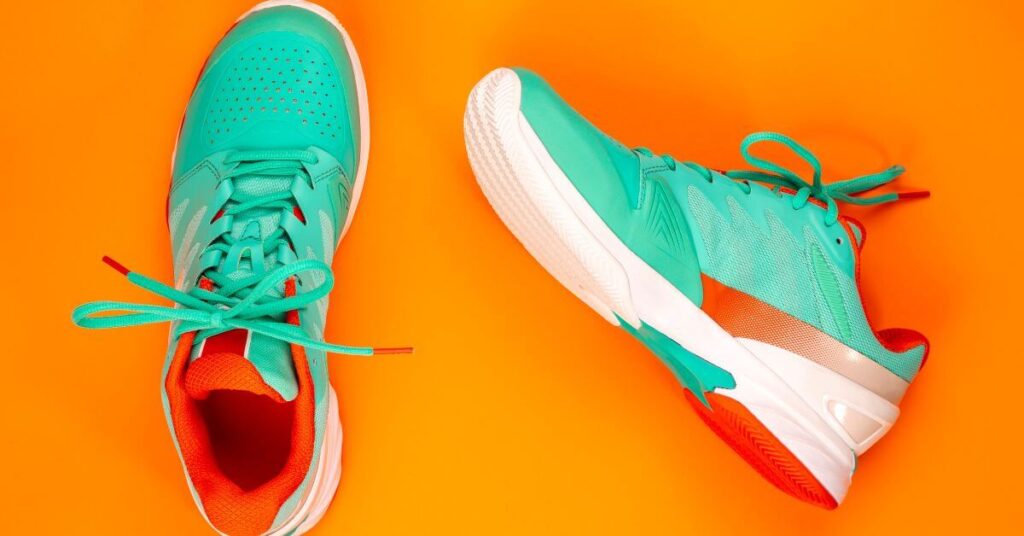If you’re anything like me, you’ve probably stood in the middle of a sports store staring at a wall of tennis shoes, wondering where to even begin. With so many brands, styles, and price tags, figuring out how to choose tennis shoes can feel more challenging than the actual game.
I’ve made a few mistakes in the past—choosing tennis shoes based solely on color or trend—and I’ve learned that the wrong pair can ruin your match and even cause injury.
In this post, I’ll walk you through what I’ve learned from personal experience, expert advice, and a few hard knocks. Whether you’re a beginner or looking to upgrade your current pair, these tips will help you make an informed, comfortable, and confident choice.
Table of Contents for How to Choose Tennis Shoes
Understand Your Playing Style and Court Type
Before diving into styles, brands, or even colours, it’s important to know where and how you’ll be playing. Trust me, knowing this upfront makes all the difference.
Hard Courts vs. Clay vs. Grass
Each court type has its own demands, and tennis shoes for different tennis court surfaces are specifically designed to meet those needs.
- Hard Courts: If you mostly play on hard surfaces, like asphalt or concrete, go for shoes that offer extra durability and cushioning. These courts are unforgiving, and I’ve found that my knees and ankles appreciate that added shock absorption.
- Clay Courts: For clay, look for a herringbone tread pattern to provide grip without clogging with clay. I once wore hard court shoes on clay and found myself sliding all over the place—lesson learned!
- Grass Courts: These are softer but more slippery. You’ll need shoes with a nub-like sole to help with traction. They’re harder to find but worth it for grass play.
Knowing what court you’ll play on is essential if you want to choose the right tennis gear for your game.
Baseline vs. Serve-and-Volley Players
Your movement style affects your shoe needs. If you’re a baseline player like me—constantly running side to side—you’ll want shoes with strong lateral support. If you rush the net often, focus on shoes with good toe reinforcement since you’ll likely drag your foot during quick stops.
Understanding this is a big part of how to choose tennis shoes that actually support your playing style.
Fit and Comfort Come First
Even the most high-tech shoes won’t help if they don’t fit well. I learned this the hard way after dealing with sore toes, blisters, and heel pain.
Try Before You Buy (Or At Least Measure Well)
Always try on tennis shoes in the evening when your feet are slightly swollen. That’s the real size you’ll be working with during a match. If you’re shopping online, make sure you know your exact foot measurements—length, width, and arch type. I always check brand size guides and read customer reviews to see if a model runs small or wide.
I used to think buying shoes online was a gamble, but once I understood how to choose tennis shoes that matched my foot shape, I started getting it right more often than not.
Support and Cushioning
Some shoes feel amazing right out of the box but lack proper arch support. If you have flat feet like me, you’ll want something with midsole structure. Those with high arches might prefer extra cushioning.
I’ve found that a shoe with the best pros cons balance gives you durability without sacrificing comfort. I remember one pair that looked amazing but left me limping after two hours—style isn’t everything!
Consider Durability and Price
Tennis shoes take a serious beating, especially if you’re playing regularly. While it’s tempting to grab the most affordable pair, I’ve learned that value matters more than price alone.
How Often Do You Play?
If you play multiple times a week, invest in a high-quality pair with strong soles and breathable uppers. I go through about two pairs a year with moderate play. It might cost more upfront, but I’ve found it the best pros to invest now than suffer later.
When to Replace Your Shoes?
Don’t wait until your shoes fall apart. If the tread is gone or you’re starting to feel aches in your feet or joints, it’s time for a new pair. Listening to your body is crucial, and from my experience, those small pains are early signs.
You’ll soon learn how to choose tennis shoes that match not just your foot, but your frequency and intensity of play.
Style, Weight, and Breathability
Let’s be honest—we all want a shoe that looks good. But beyond the colour, design affects everything from comfort to performance.
Lightweight or Structured?
Some shoes are featherlight, making you feel faster and more agile. I love these for practice sessions or quick matches. But lighter shoes often mean less support. For longer matches or tougher courts, a sturdier shoe works better.
That balance—it’s the best pros for mobility versus protection—is worth considering.
Breathable Uppers
Breathable materials matter more than I realized. I once wore a pair with minimal ventilation, and by the end of the match, my feet were soaked and sore. Shoes with mesh panels or ventilation zones keep your feet cooler, dryer, and happier.
When comparing options, remember the pros cons what makes it less ideal—poor airflow, uncomfortable stiffness, or low durability.
Quick Recap: How to Choose Tennis Shoes Like a Pro
- Know your court surface – Pick tennis shoes for different surfaces tailored to hard, clay, or grass.
- Play to your style – Are you a baseliner or serve-and-volley player?
- Prioritise fit and comfort – Never compromise on arch support and breathability.
- Factor in durability and price – Think long-term, especially if you play often.
- Compare thoughtfully – Think about the best pros and cons, not just aesthetics.
Ultimately, it’s not just about the trendiest pair. Ask yourself: does this shoe feel good, support my game, and last long enough to be worth it?
You don’t need to be a professional athlete to care about gear. In fact, the more recreational you are, the more important it is to wear supportive shoes. If you’re unsure, ask for help, read reviews, and take your time. Once you understand how to choose tennis shoes, it becomes easier to find the perfect fit every time.
So next time you’re facing a shelf full of options, or scrolling endlessly online, don’t panic. You’ve got the knowledge now to make the smart pick. And when your feet feel good, trust me—your whole game improves.
More about How to Choose Tennis Shoes
How Do I Know What Tennis Shoes to Buy?
When I first started playing tennis regularly, I had no idea what to look for in a shoe. I went for whatever looked cool—and regretted it almost immediately after my first long match. What helped me was learning how to choose tennis shoes based on my playing style and the surface I was using most (which was hard court, for me).
Once I understood the need for lateral support, durable soles, and proper cushioning for my foot type, the whole process became a lot easier. I always recommend thinking about where you play, how often, and whether you need extra support or breathability—those clues will point you to the right pair.
How to Pick a Pair of Tennis Shoes?
Honestly, picking the right pair used to overwhelm me. But now, I approach it like I would choosing the right tennis racquet—it’s all about fit and feel. The key to how to choose tennis shoes is trying on a few different pairs and walking around in them.
Do they feel snug but not tight? Can you move side-to-side comfortably? I also check if the sole pattern matches the court I play on most often. Once I stopped chasing trends and started focusing on how the shoe performed for my needs, picking a pair became way less stressful—and way more satisfying.
What Type of Shoe Is Best for Tennis?
From my experience, the best tennis shoe is one that supports your movements on court—whether you’re sprinting to the net or sliding along the baseline. For me, that meant finding a pair with strong lateral support, a durable sole for hard courts, and a slightly wider toe box.
Learning how to choose tennis shoes made me realise there’s no “one-size-fits-all” answer—it really depends on your foot shape, the court surface, and how you move during play. It’s a bit like choosing your ideal doubles partner—there has to be chemistry!
Should You Size Up or Down in Tennis Shoes?
This was a big learning moment for me. At first, I wore shoes that were my exact size, but after a few matches, I noticed my toes were taking a beating. That’s when I learned that tennis shoes should offer a little bit of extra space—especially in the toe box—to account for all that forward motion.
In most cases, sizing up by half a size works best, but again, it’s part of understanding how to choose tennis shoes that actually work for your feet. I always try them on with my usual tennis socks to make sure the fit is perfect.
Final Thoughts: Finding Your Perfect Match
Choosing the right pair of tennis shoes might take a bit of trial and error, but once you get it right, it makes a world of difference. Your shoes should support your style, fit like a glove, and hold up to your schedule.
From my own journey, I can confidently say that understanding how to choose tennis shoes has improved not only my comfort on the court but my performance too. I used to dread long matches because of foot pain—now, I feel ready and energized.









